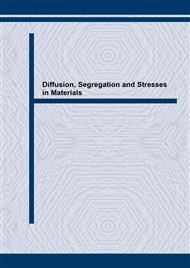[1]
A.N. King: Int. Mater. Rev. Vol. 32 (1987), p.173
Google Scholar
[2]
Yu.R. Kolobov, V.B. Marvin, I.V. Ratochka and A.D. Korotaev: Doklady AN SSSR Vol. 283 (1985), p.605
Google Scholar
[3]
Yu.R. Kolobov and I.V. Ratochka: J. Mater. Sci. Technol. Vol. 11 (1995), p.38
Google Scholar
[4]
R. Birringer and H. Gleiter: In Encyclopedia of Materials, ed. R.W. Cahn (Pergamon Press, Oxford, 1988).
Google Scholar
[5]
Yu.R. Kolobov, R.Z. Valiev, G.P. Grabovetskaya, A.P. Zhilyaev, E.F. Dudarev, K.V. Ivanov, M.B. Ivanov, O.A. Kashin and E.V. Naidenkin: In Grain Boundary Diffusion and Properties of Nanostructured Materials. Eds. Yu. Kolobov and R. Valiev (Novosibirsk, Nauka, 2001) (in Russian).
DOI: 10.1016/s1359-6462(00)00699-0
Google Scholar
[6]
G.P. Grabovetskaya, I.V. Ratochka, Yu.R. Kolobov and L.N. Puchkareva: Phys. Met. Metallogr. Vol. 3 (1997), p.112
Google Scholar
[7]
Yu.R. Kolobov, G.P. Grabovetskaya, M.B. Ivanov, A.P. Zhilyaev and R.Z. Valiev: Scr. Mater. Vol. 44 (2001), p.873
Google Scholar
[8]
Yu.R. Kolobov, G.P. Grabovetskaya, K.V. Ivanov and N.V. Girsova: Phys. Met. Metallogr. Vol. 5 (2001), p.105
Google Scholar
[9]
Yu.R. Kolobov, G.P. Grabovetskaya, I.V. Ratochka and K.V. Ivanov: Nanostruc. Mater. Vol. 12 (1999), p.1127
Google Scholar
[10]
Yu.R. Kolobov, G.P. Grabovetskaya, K.V. Ivanov and M.B. Ivanov: Interf. Sci. Vol. 9 (2001), p.389
Google Scholar
[11]
R.Z. Valiev, E.V. Kozlov, Yu.F. Ivanov, J. Lian, A.A. Nazarov and B. Baudelet: Acta Metall. Mater. Vol. 42 (1994), p.2467
DOI: 10.1016/0956-7151(94)90326-3
Google Scholar
[12]
H.-E. Schaefer, K. Reimann, W. Straub, F. Phillipp, H. Tanimoto, U. Brossmann and R. Wurschum: Mater. Sci. Eng. A Vol. A 286 (2000) p.24
Google Scholar
[13]
R. Würschum, K. Reimann, S. Gru� , A. Kübler, P. Scharwaechter, W. Frank, O. Kruse, H.D. Carstanjen and H.-E. Schaefer: Phil. Mag. B Vol. B76 (1997), p.407
Google Scholar
[14]
R.Z. Valiev and R.K. Islamgaliev: In Superplasticity - Current Status and Future Potential. Eds. P.B. Berbon, M.Z. Berbon et al., Symposium Proceedings. Vol. 601 (MRS, Warrendale, Pennsylvania), p.335
Google Scholar
[15]
Yu.R. Kolobov, E.V. Naidenkin, E.F. Dudarev, G.P. Bakach, Yu.I. Pochivalov and N.V. Girsova: Izv. Vuz. Fiz. Vol. 5 (2002), p.23 (in Russian)
DOI: 10.1023/a:1021024203376
Google Scholar
[16]
Yu.R. Kolobov, G.P. Grabovetskaya, M.B. Ivanov, K.V. Ivanov and N.V. Girsova: Proc. Symposium "Physics and Mechanics of Large Plastic Strains", St. Petersburg, 2002 (to be published).
Google Scholar
[17]
V.V. Slyezov and V.V. Sagalovich: Usp. Fiz. Nauk Vol. 151 (1987), pp.67-23 (in Russian)
Google Scholar
[18]
I. Kaur, Yu. Mishin and W. Gust: Fundamentals of Grain and Interphase Boundary Diffusion (John Wiley, Chichester 1995). Discussion H. Mehrer: Could you please comment on recrystallization of nanocrystalline nickel and titanium? Yu. Kolobov: The recrystallization temperature of nanocrystalline nickel and titanium is approximately 250°C and 350°, respectively. During the creep tests there were no recrystallization. B. Bokstein: What are the methods of sectioning in your GB diffusion experiments? Yu. Kolobov: We use two methods of sectioning: mechanical and ion-beam. B. Bokstein: DGB in nanomaterials exceed DGB in the coarse grained materials by 10-102. For what properties is it important? Only for creep? Or also for something else? Are these 102 at the scatter range of in nanostructured metals? Yu. Kolobov: The increase of DGB influences practically all mechanical properties controlled by diffusion. That is creep, superplasticity, influence of the environment on the above mentioned properties. Of coarse, our scatter is large, and it is large also for other data obtained in the direct diffusion investigations too. However, temperature shifts of the maximal effect of creep activation and superpasticity occurence give us the additional information. These shifts allow us to make our estimations for GB diffusivity in nanostructured metals in comparison with coarse-grained ones. Dr. L. Demchenko and prof. Yu. Makogon
Google Scholar


